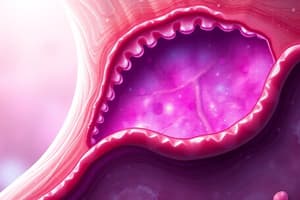Podcast
Questions and Answers
Which statement accurately describes the epidermis?
Which statement accurately describes the epidermis?
- The surface layer is composed of keratinized stratified squamous epithelium. (correct)
- The epidermis is primarily made up of mesodermal connective tissue.
- The epidermis is vascular and consists of cuboidal epithelium.
- The epidermis does not produce keratinocytes.
What is the primary function of dermal papillae?
What is the primary function of dermal papillae?
- To insulate the body temperature through adipose tissue.
- To strengthen the adhesion between the dermis and epidermis. (correct)
- To produce melanin for the skin.
- To facilitate the secretion of sweat and sebaceous glands.
What type of cells primarily undergo keratinization in the epidermis?
What type of cells primarily undergo keratinization in the epidermis?
- Keratinocytes (correct)
- Melanocytes
- Adipocytes
- Fibroblasts
Which layer of the epidermis is mitotically active and contains cuboidal cells?
Which layer of the epidermis is mitotically active and contains cuboidal cells?
Which structure is NOT a derivative of the epidermis?
Which structure is NOT a derivative of the epidermis?
Which of the following best describes the layers of the epidermis from the basement membrane to the skin surface?
Which of the following best describes the layers of the epidermis from the basement membrane to the skin surface?
What role do melanocytes play in the epidermis?
What role do melanocytes play in the epidermis?
What percentage of total body weight is accounted for by skin?
What percentage of total body weight is accounted for by skin?
Which component is NOT part of the subcutaneous tissue?
Which component is NOT part of the subcutaneous tissue?
How does the dermis contribute to the function of the skin?
How does the dermis contribute to the function of the skin?
Which of the following layers of the skin is NOT one of the three main layers?
Which of the following layers of the skin is NOT one of the three main layers?
What is the thickness of skin on the eyelids?
What is the thickness of skin on the eyelids?
What is the maximum thickness of skin, found on the heels of the feet?
What is the maximum thickness of skin, found on the heels of the feet?
What term is often used interchangeably with 'skin'?
What term is often used interchangeably with 'skin'?
Which of the following activities is NOT mentioned in the module’s objectives?
Which of the following activities is NOT mentioned in the module’s objectives?
How does understanding the histological structure of the skin relate to functional impairment?
How does understanding the histological structure of the skin relate to functional impairment?
Which of the following textbooks is suggested for reading in the module?
Which of the following textbooks is suggested for reading in the module?
In which year was the 15th edition of Junqueira's Basic Histology published?
In which year was the 15th edition of Junqueira's Basic Histology published?
What is a characteristic of thick skin?
What is a characteristic of thick skin?
Which layer of the epidermis is the deepest?
Which layer of the epidermis is the deepest?
What effect does the contraction of the arrectores pilorum muscle have on hair?
What effect does the contraction of the arrectores pilorum muscle have on hair?
Which skin type is associated with abundant sweat glands and absent pilosebaceous units?
Which skin type is associated with abundant sweat glands and absent pilosebaceous units?
What is a notable feature of the stratum spinosum layer?
What is a notable feature of the stratum spinosum layer?
Where is thin skin predominantly found?
Where is thin skin predominantly found?
What type of keratin is found in nails?
What type of keratin is found in nails?
Which of the following is NOT a function of the dermal papillae in thick skin?
Which of the following is NOT a function of the dermal papillae in thick skin?
What distinguishes thin skin from thick skin?
What distinguishes thin skin from thick skin?
What is the primary function of the structure identified in the question?
What is the primary function of the structure identified in the question?
Which of the following correctly identifies the pointed layers of the structure?
Which of the following correctly identifies the pointed layers of the structure?
Which of the following structures is NOT typically found within the hair follicle?
Which of the following structures is NOT typically found within the hair follicle?
What special stain is typically used to visualize the structures related to the hair follicle?
What special stain is typically used to visualize the structures related to the hair follicle?
Which of the following accurately differentiates eccrine from apocrine glands?
Which of the following accurately differentiates eccrine from apocrine glands?
What is the structure formed as a result of hair follicle development?
What is the structure formed as a result of hair follicle development?
Which part is most likely responsible for the secretion of oily substances in the hair follicle?
Which part is most likely responsible for the secretion of oily substances in the hair follicle?
Which characteristic is NOT a distinguishing feature of eccrine glands?
Which characteristic is NOT a distinguishing feature of eccrine glands?
Which function is primarily associated with the arrector pili muscle?
Which function is primarily associated with the arrector pili muscle?
What is the primary function of melanocytes in the epidermis?
What is the primary function of melanocytes in the epidermis?
Which layer of the epidermis is primarily associated with the presence of Langerhans cells?
Which layer of the epidermis is primarily associated with the presence of Langerhans cells?
How long does it typically take for epidermal cells to move from the basal layer to the outer layers and be shed?
How long does it typically take for epidermal cells to move from the basal layer to the outer layers and be shed?
What is a defining characteristic of the stratum corneum?
What is a defining characteristic of the stratum corneum?
What additional component is found in the stratum granulosum that aids in cellular structure?
What additional component is found in the stratum granulosum that aids in cellular structure?
Where are Merkel cells located within the layers of the skin and what is their function?
Where are Merkel cells located within the layers of the skin and what is their function?
What is the term used for the continuous shedding and replacement of cells in the epidermis?
What is the term used for the continuous shedding and replacement of cells in the epidermis?
Which layer of the epidermis is also known as stratum Malpighii?
Which layer of the epidermis is also known as stratum Malpighii?
What distinguishes the stratum lucidum from other layers of the epidermis?
What distinguishes the stratum lucidum from other layers of the epidermis?
Study Notes
Integumentary System Overview
- Skin is the largest organ, making up 15%-20% of total body weight.
- Thickness varies: 0.5 mm on eyelids to 4.0 mm on heels.
- Consists of three main layers: epidermis, dermis, and hypodermis (subcutaneous tissue).
- Epidermis is nonvascular, composed of keratinized stratified squamous epithelium.
- Dermis is mesodermal connective tissue supporting the epidermis, featuring dermal papillae for enhanced adhesion.
Skin Functions
- Offers protective, sensory, thermoregulatory, and metabolic functions.
- Key regions contributing to these functions are epidermis, dermis, and hypodermis.
Epidermal Structure
-
Keratinocytes
- Most numerous cells undergoing keratinization as they move from the basal layer to the skin surface.
- Five layers:
- Stratum basale: single layer of mitotically active cuboidal cells.
- Stratum spinosum: several layers of polyhedral cells with a spiny appearance.
- Stratum granulosum: thinner layer with flattened keratinocytes containing keratohyalin granules.
- Stratum lucidum: found only in thick skin, consists of non-nucleated cells.
- Stratum corneum: outermost layer of dead, flattened, keratin-filled cells.
-
Melanocytes
- Located in the stratum basale and spinosum; synthesize and transfer melanin to keratinocytes.
- Distinct under special stains (e.g., DOPA).
-
Langerhans Cells
- Immune cells located in the stratum spinosum that trap surface antigens.
-
Merkel Cells
- Found in the stratum basale; act as mechanoreceptors for touch sensation.
Hair and Muscle Structures
- Arrectores pilorum muscle: Attaches to hair follicles, causing hair to stand up when contracted (goosebumps).
Skin Classification
- Thick Skin: Found in palms and soles, features a robust stratum corneum and more sweat glands, lacks hair follicles.
- Thin Skin: Found on the face, characterized by a thinner stratum corneum and more pilosebaceous units.
Histological Techniques
- Hematoxylin and Eosin (H&E) staining is commonly used for observing skin layers.
- Specialized staining may be used to enhance visualization of specific cell types and structures.
Key Identifications and Differentiations
- Stratum basale (deepest layer) and stratum spinosum (above, spiny appearance).
- Identification of hair follicle components and distinguishing eccrine from apocrine glands.
Study Recommendations
- Review Junqueira's Basic Histology and Wheater’s Functional Histology for detailed understanding of skin structure and function.
- Attend lectures and participate in laboratory activities for hands-on learning experiences.
Studying That Suits You
Use AI to generate personalized quizzes and flashcards to suit your learning preferences.
Related Documents
Description
Test your knowledge on the histology of the integumentary system, focusing on skin and its appendages. This quiz is designed for MD 103 Laboratory students at the University of Northern Philippines and will challenge your understanding of microscopic body structures. Prepare to dive deep into the intricacies of skin anatomy!




